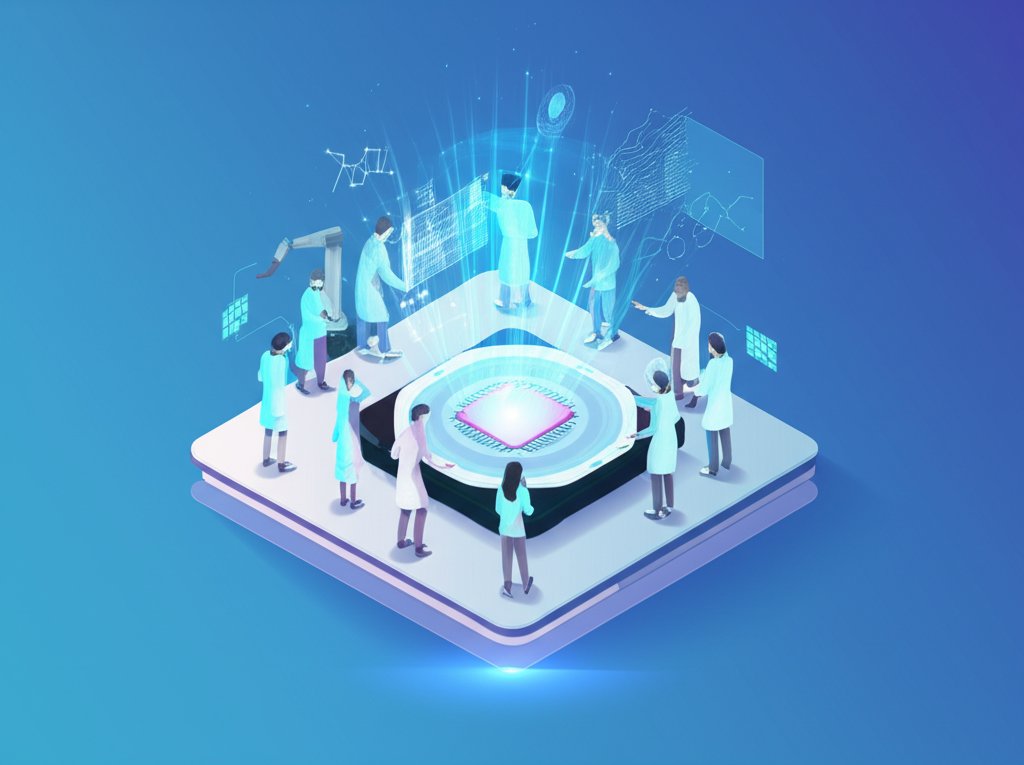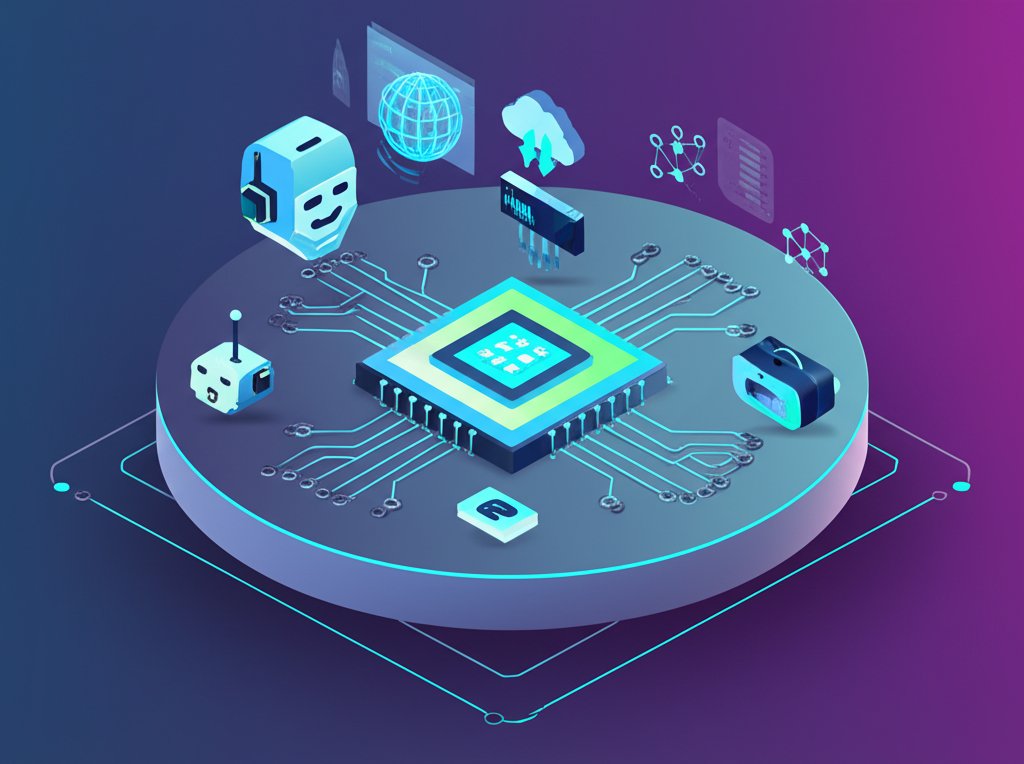Imagine a world where your car drives itself, diseases are cured by personalized medicines, and virtual realities feel indistinguishable from the physical. This isn’t science fiction; it’s the near future, powered by what is the cutting edge technology. These aren’t just incremental improvements; they are revolutionary breakthroughs that redefine what’s possible, reshaping industries, economies, and our daily lives at an unprecedented pace.
If you’re eager to understand the technologies that are not only making waves today but are set to dominate tomorrow, you’ve come to the right place. This article will demystify cutting-edge tech, explain its profound importance, and dive deep into the hottest future trends that are already beginning to define our world. Get ready to explore the innovations that are propelling humanity forward into an era of extraordinary possibilities.
To fully appreciate how far we’ve come, it’s worth considering some interesting facts about technology and its rapid evolution.
Defining Cutting-Edge Technology: The Vanguard of Innovation
At its core, cutting-edge technology refers to the most advanced, innovative, and transformative solutions available, pushing the boundaries of what was previously considered achievable. It’s the “bleeding edge” – the absolute forefront of scientific and engineering progress.
Think of it as the leading wave of innovation, characterized by its ability to disrupt existing paradigms, create entirely new markets, and solve complex problems with previously unimaginable efficiency and effectiveness. It’s not just about being new; it’s about being fundamentally game-changing.
What Makes Technology “Cutting-Edge”?
Several key characteristics define a technology as truly cutting-edge:
- Novelty and Originality: It often introduces entirely new concepts, methods, or applications that haven’t existed before, or it represents a radical improvement over existing solutions. This isn’t just a faster processor; it’s a completely new way of computing.
- Transformative Potential: Cutting-edge tech doesn’t just optimize; it revolutionizes. It has the power to fundamentally alter industries, create new business models, or significantly change societal behaviors and capabilities.
- High Impact and Scalability: While often starting in specialized niches, truly cutting-edge technologies possess the potential for widespread adoption across multiple sectors and can deliver significant benefits on a large scale.
- Pushes Boundaries of Current Capabilities: It often requires overcoming significant scientific or engineering challenges, pushing the limits of current knowledge and resources. It’s born from ambitious research and development.
- Future-Oriented: While some cutting-edge technologies are in their early adoption phases, many are still in development or just beginning to show their full potential, signaling a clear path to future dominance.
Why Does Cutting-Edge Tech Matter for Everyone?
Understanding and engaging with cutting-edge technology isn’t just for tech enthusiasts or scientists; it’s crucial for businesses, governments, and individuals alike.
- Economic Growth and Competitive Advantage: For businesses, embracing cutting-edge tech is vital for staying competitive, driving efficiency, creating new products and services, and unlocking new revenue streams. Nations that foster such innovation often lead global economies.
- Solving Grand Challenges: From climate change and sustainable energy to healthcare crises and food security, cutting-edge technologies offer powerful tools to tackle humanity’s most pressing problems.
- Societal Advancement: These innovations enhance quality of life, improve communication, expand access to education and healthcare, and create new forms of entertainment and human connection.
- Job Creation and Skill Evolution: While some jobs may be automated, cutting-edge tech simultaneously creates entirely new industries and demands for specialized skills, fostering economic dynamism and new career paths.
- Strategic National Security: Governments leverage these advancements for defense, intelligence, critical infrastructure protection, and maintaining a technological edge on the global stage.
In essence, cutting-edge technology isn’t just a luxury; it’s the engine of progress, a strategic imperative for prosperity, and a blueprint for our collective future.
The Hottest Cutting-Edge Technology Trends Shaping Our Future
The landscape of innovation is constantly shifting, but certain trends stand out for their transformative potential and rapid evolution. Here are the hottest cutting-edge technologies poised to redefine the next decade and beyond:
Generative AI & Advanced Machine Learning: Beyond Automation
While Artificial Intelligence (AI) has been around for decades, recent breakthroughs, particularly in Generative AI and deep learning, have propelled it to the forefront of cutting-edge technology. This isn’t just about processing data; it’s about creating it.
- What it is: Generative AI uses sophisticated algorithms to create new content—text, images, audio, video, code—that is indistinguishable from human-created output. This includes large language models (LLMs) like ChatGPT, image generators like Midjourney, and tools that can write software or compose music. Advanced Machine Learning encompasses self-improving algorithms, reinforcement learning, and AI that can learn from minimal data.
- Why it’s cutting-edge: The ability of AI to create rather than just analyze unlocks unprecedented levels of automation, personalization, and creativity. It’s transforming industries from entertainment and marketing to scientific research and software development.
- Future Trends:
- Hyper-Personalization: AI generating tailored experiences, content, and products for every individual.
- Autonomous Agent Networks: AIs collaborating to achieve complex goals without constant human oversight.
- AI for Scientific Discovery: Accelerating drug discovery, material science, and climate modeling.
- Multimodal AI: Systems that can understand and generate across different data types (text, image, sound) simultaneously.
- Real-world Impact:
- Content Creation: AI-powered tools assisting writers, designers, and musicians.
- Customer Service: Advanced chatbots providing more natural and effective interactions.
- Software Development: AI generating code, debugging, and assisting in project management.
- Healthcare: AI designing new molecules, diagnosing diseases from medical images, and personalizing treatment plans.
Quantum Computing: The Next Computational Revolution
Quantum computing represents a paradigm shift from classical computing, promising to solve problems currently intractable for even the most powerful supercomputers.
- What it is: Unlike classical computers that use bits (0 or 1), quantum computers use “qubits” which can exist in multiple states simultaneously (superposition) and be entangled with one another. This allows them to process vast amounts of information in parallel, leading to exponential increases in computational power for specific tasks.
- Why it’s cutting-edge: It’s still in its nascent stages, but the potential is enormous. It promises to unlock solutions to problems in materials science, drug discovery, cryptography, and complex optimization that are beyond the reach of current technology.
- Future Trends:
- Quantum Supremacy Milestones: Demonstrating quantum computers solving problems that classical computers cannot realistically solve in a lifetime.
- Error Correction Improvements: Overcoming the inherent instability of qubits to build more robust and reliable quantum machines.
- Hybrid Quantum-Classical Algorithms: Combining quantum processors with classical computers to leverage the strengths of both.
- Real-world Impact:
- Drug Discovery: Simulating molecular interactions with unprecedented accuracy to design new pharmaceuticals.
- Materials Science: Creating novel materials with tailored properties (e.g., superconductors, more efficient batteries).
- Financial Modeling: Optimizing complex portfolios and risk assessments.
- Cryptography: Potentially breaking current encryption methods, but also enabling new, unhackable quantum encryption.
Extended Reality (XR): Merging Digital and Physical Worlds
Extended Reality (XR) is an umbrella term encompassing Virtual Reality (VR), Augmented Reality (AR), and Mixed Reality (MR), all of which blend the real and virtual worlds to create immersive experiences.
- What it is:
- VR: Completely immerses users in a simulated environment, shutting out the physical world. (e.g., Meta Quest headsets for gaming, training).
- AR: Overlays digital information onto the real world, enhancing what you see. (e.g., Snapchat filters, Pokémon Go, industrial maintenance apps).
- MR: Blends real and virtual objects to interact in real-time within a shared environment, allowing digital objects to respond to the physical world. (e.g., Microsoft HoloLens for collaborative design).
- Why it’s cutting-edge: XR is moving beyond niche gaming applications to revolutionize how we work, learn, communicate, and interact with information, promising more intuitive and deeply engaging experiences than traditional flat screens.
- Future Trends:
- Pervasive AR: Lightweight, stylish AR glasses becoming a common computational interface.
- Tactile and Olfactory Feedback: Adding realistic touch and smell to XR experiences for full sensory immersion.
- The Metaverse: Interconnected, persistent virtual worlds for social interaction, commerce, and work.
- Neural Interfaces: Technologies that allow direct brain-computer interaction with XR environments.
- Real-world Impact:
- Training & Simulation: Realistic simulations for surgeons, pilots, and industrial workers.
- Education: Immersive virtual classrooms and interactive learning experiences.
- Design & Engineering: Collaborative 3D design reviews and prototyping.
- Healthcare: VR for therapy (pain management, PTSD) and surgical planning.
- Retail: Virtual try-ons, interactive product visualization.
Sustainable Tech (Green Tech): Innovations for a Greener Planet
As environmental concerns grow, technology focused on sustainability, often termed “Green Tech,” is becoming critically cutting-edge. It harnesses innovation to address climate change, resource depletion, and pollution.
- What it is: This category includes a broad array of technologies designed to reduce human impact on the environment. Examples include advanced renewable energy generation and storage, carbon capture and utilization (CCU) systems, sustainable agriculture tech, waste-to-energy solutions, eco-friendly materials science, and smart grids.
- Why it’s cutting-edge: It’s not just about doing less harm; it’s about actively reversing damage and creating circular economies. These innovations are critical for global survival and prosperity, driving massive investment and research.
- Future Trends:
- AI-Optimized Energy Grids: Intelligent systems managing renewable energy sources and consumption for maximum efficiency.
- Direct Air Capture (DAC): Technologies that literally pull carbon dioxide from the atmosphere at scale.
- Bio-fabrication & Lab-Grown Materials: Producing goods, food components, and even construction materials with minimal environmental footprint.
- Advanced Battery and Energy Storage: Breakthroughs in solid-state batteries, flow batteries, and other long-duration storage solutions.
- Precision Agriculture: Drones, sensors, and AI optimizing crop yields, water usage, and pesticide application.
- Real-world Impact:
- Energy Independence: Countries relying more on renewable energy sources.
- Reduced Waste: Innovative recycling, upcycling, and waste conversion processes.
- Cleaner Air & Water: Technologies that actively remove pollutants.
- Sustainable Manufacturing: Industries adopting cleaner production methods and materials.
Advanced Robotics & Autonomous Systems: From Industry to Daily Life
Robots are evolving beyond repetitive industrial tasks to become intelligent, adaptable, and increasingly integrated into our daily lives, making this a pivotal area for cutting-edge technology.
- What it is: This includes sophisticated humanoid robots, collaborative robots (cobots) that work alongside humans, autonomous vehicles (cars, drones, ships), delivery robots, and AI-powered automation systems capable of complex decision-making and navigation in unstructured environments.
- Why it’s cutting-edge: Advances in AI, sensor technology, and mechanical engineering are enabling robots to perceive, reason, and act with unprecedented autonomy and versatility, moving from programmed tools to intelligent agents.
- Future Trends:
- General-Purpose Humanoid Robots: Robots capable of performing a wide range of tasks in various human-centric environments.
- Swarm Robotics: Large numbers of small, simple robots working together to achieve complex goals.
- Hyper-Personalized Logistics: Autonomous fleets and drone networks delivering goods with unmatched speed and precision.
- Robots in Service Industries: From hospitality to elder care, robots assisting in new social roles.
- Real-world Impact:
- Manufacturing: Flexible automation, increased productivity, and safer working conditions.
- Logistics & Delivery: Automated warehouses, last-mile delivery by drones and ground robots.
- Healthcare: Surgical robots, patient monitoring, and assistive devices for the elderly.
- Exploration: Robots operating in hazardous or inaccessible environments (space, deep sea, disaster zones).
Biotechnology & Gene Editing: Redefining Health and Life
Biotechnology, especially in areas like gene editing and synthetic biology, stands as one of the most profound cutting-edge technologies, promising to revolutionize medicine, agriculture, and even fundamental understanding of life.
- What it is: This includes CRISPR-Cas9 for precise gene editing, personalized medicine (tailoring treatments based on an individual’s genetic makeup), mRNA vaccine technology, synthetic biology (designing and building new biological parts, devices, and systems), and advanced diagnostics powered by AI.
- Why it’s cutting-edge: These technologies offer the ability to directly manipulate biological systems, potentially curing genetic diseases, developing novel therapies, enhancing food production, and even engineering new life forms. The ethical implications are as profound as the scientific potential.
- Future Trends:
- In Vivo Gene Editing: Directly altering genes within the body to treat diseases.
- CRISPR for Disease Prevention: Proactively modifying genes to prevent inherited conditions before they manifest.
- Organoids & ‘Organs-on-a-Chip’: Miniature, lab-grown organs for drug testing, disease modeling, and eventually transplantation.
- Personalized Microbiome Engineering: Tailoring gut bacteria to improve health and treat conditions.
- Advanced Bio-sensors: Real-time, non-invasive health monitoring and early disease detection.
- Real-world Impact:
- Curing Genetic Diseases: Potential treatments for cystic fibrosis, Huntington’s disease, sickle cell anemia.
- Cancer Therapies: CAR T-cell therapy and other immunotherapies.
- Agriculture: Creating disease-resistant crops and improving nutritional content.
- Pandemic Response: Rapid development of vaccines and diagnostics (as seen with mRNA vaccines for COVID-19).
Edge Computing & Distributed Cloud: Real-time Intelligence Everywhere
As the Internet of Things (IoT) proliferates and demand for real-time processing grows, Edge Computing and Distributed Cloud have become essential cutting-edge technologies.
- What it is:
- Edge Computing: Processing data closer to the source of generation (the “edge” of the network), instead of sending it all to a centralized cloud server. This means smart devices, sensors, and local servers can analyze data instantly.
- Distributed Cloud: Extends public cloud services to different geographical locations, bringing cloud functionalities (compute, storage, databases) closer to where they are needed, whether on-premises, in other data centers, or at the network edge.
- Why it’s cutting-edge: These approaches dramatically reduce latency, conserve bandwidth, enhance security, and enable real-time decision-making crucial for autonomous systems, industrial IoT, and interactive XR experiences.
- Future Trends:
- Hyper-Distributed Architectures: Networks of interconnected edge devices, local clouds, and central clouds forming a seamless computing fabric.
- AI at the Edge: Smaller, more efficient AI models running directly on devices for instant insights without cloud dependency.
- 5G/6G Integration: Next-generation wireless networks providing the bandwidth and low latency necessary for widespread edge adoption.
- Federated Learning: AI models trained collaboratively across many edge devices without sharing raw data, enhancing privacy.
- Real-world Impact:
- Autonomous Vehicles: Instant processing of sensor data for navigation and safety decisions.
- Smart Factories: Real-time machine monitoring, predictive maintenance, and quality control.
- Smart Cities: Managing traffic, public safety, and energy use with immediate data insights.
- Immersive XR: Delivering high-fidelity virtual and augmented reality experiences with minimal lag.
Cybersecurity Innovations: Protecting the Digital Frontier
With every technological advance, new vulnerabilities emerge. Cutting-edge cybersecurity is crucial for protecting our increasingly digital world from sophisticated threats.
- What it is: This area includes AI-powered threat detection and response, quantum-resistant cryptography, Zero Trust security models, behavioral biometrics, and advanced methods for protecting data in distributed and cloud environments.
- Why it’s cutting-edge: As cybercriminals leverage AI and quantum computing, defenses must evolve rapidly. Innovation in cybersecurity is a constant arms race, essential for maintaining trust and stability in digital infrastructure.
- Future Trends:
- AI-Native Security: Security systems that not only use AI for detection but are fundamentally designed around AI for proactive defense and autonomous response.
- Post-Quantum Cryptography: Developing new encryption algorithms that are resistant to attacks from future quantum computers.
- Zero-Trust Everything: A security framework that assumes no user or device can be trusted by default, requiring continuous verification regardless of network location.
- Behavioral Analytics for Identity: Using unique user behaviors (typing patterns, mouse movements) for continuous authentication.
- Real-world Impact:
- Enhanced Data Protection: Securing sensitive personal, corporate, and governmental information.
- Resilient Infrastructure: Protecting critical systems like power grids and financial networks.
- Combating Cybercrime: More effective tools against ransomware, phishing, and state-sponsored attacks.
- Privacy Preservation: Technologies allowing data analysis while maintaining user anonymity.
The Impact and Implications of Cutting-Edge Technology
The widespread adoption of cutting-edge technology brings with it profound impacts that extend far beyond technical specifications. These innovations reshape our world in multifaceted ways.
Economic Transformation and Job Evolution
Cutting-edge tech is a relentless engine of economic change. It creates entirely new industries (e.g., the app economy, AI services) and transforms existing ones. Automation, driven by AI and robotics, increases productivity and efficiency, leading to economic growth. However, it also necessitates a re-evaluation of the workforce. While some jobs may be displaced, a multitude of new roles emerge, requiring skills in data science, AI engineering, robotics maintenance, ethical AI oversight, and more. Lifelong learning and adaptability become paramount for individuals and national economies.
Ethical Considerations and Societal Responsibilities
As technology advances, so do the ethical dilemmas. Questions surrounding AI bias, data privacy, the use of gene-editing, the environmental footprint of large-scale computing, and the potential for autonomous weapons systems are becoming increasingly urgent. Societies and policymakers face the challenge of creating frameworks for responsible innovation—ensuring that the benefits are broadly distributed, risks are mitigated, and human values remain at the core of technological development. AI governance, as touched upon in the original article, is a critical component here.
The Role of Innovation Leaders and Future Investment
Companies, research institutions, and governments that invest heavily in R&D are the “innovation leaders” at the forefront of this progress. Their foresight and funding drive the breakthroughs. Venture capital flows into promising startups, and established tech giants acquire or develop new capabilities, creating a vibrant ecosystem of innovation. This continuous cycle of investment, research, and application is essential for accelerating the pace of cutting-edge development and bringing these future trends to fruition.
How to Stay Ahead in the Era of Rapid Tech Advancements

In a world defined by lightning-fast innovation, staying informed and adaptable is not just an advantage; it’s a necessity.
Continuous Learning and Skill Development
For individuals, the most critical step is to embrace a mindset of continuous learning. This means:
- Exploring Online Courses: Platforms like Coursera, edX, and Udacity offer courses in AI, data science, cybersecurity, and blockchain.
- Attending Webinars and Conferences: Stay updated on the latest research and industry applications.
- Reading Industry Publications: Follow leading tech blogs, journals, and news outlets.
- Developing “Soft” Skills: Critical thinking, problem-solving, creativity, and adaptability are highly valued alongside technical expertise.
Fostering an Innovation Culture in Business
For businesses, strategic engagement with cutting-edge tech means:
- Investing in R&D: Allocating resources to explore and pilot new technologies.
- Encouraging Experimentation: Creating a safe environment for teams to test new ideas, even if they fail.
- Cross-Functional Collaboration: Breaking down silos to allow diverse teams to contribute to technological solutions.
- Strategic Partnerships: Collaborating with startups, research institutions, or other companies to access expertise and accelerate innovation.
Strategic Adoption and Pilot Programs
Don’t wait for a technology to be fully mature to consider it. Proactive engagement includes:
- Identifying Relevant Technologies: Determine which cutting-edge trends align with your strategic goals and address your specific challenges.
- Running Pilot Programs: Test new technologies on a small scale to understand their real-world applicability, identify hurdles, and gather insights before a full-scale rollout.
- Developing a Tech Roadmap: Plan for the integration of future technologies into your business operations over time.
Conclusion: Embracing the Infinite Possibilities
We stand on the precipice of an era defined by extraordinary technological potential. From the creative power of Generative AI and the boundless promise of Quantum Computing to the immersive worlds of XR and the life-altering advancements in Biotechnology, what is the cutting edge technology is not merely a collection of tools; it’s a force reshaping our reality.
These innovations promise solutions to humanity’s greatest challenges, drive unprecedented economic growth, and redefine the very fabric of our daily lives. While ethical considerations and responsible governance are paramount, the future illuminated by these trends is one of infinite possibilities. By understanding, embracing, and strategically engaging with these advancements, we can collectively steer the course toward a more intelligent, connected, and sustainable future. The journey has just begun, and the most exciting chapters are yet to be written.
FAQ
What exactly is cutting-edge technology?
Cutting-edge technology refers to the most advanced, innovative, and transformative solutions currently available or in rapid development. It pushes the boundaries of existing capabilities, often disrupting industries and creating new possibilities that were previously unimaginable. It’s characterized by its novelty, high impact, and potential for widespread adoption.
Why is understanding cutting-edge tech important for businesses?
For businesses, understanding cutting-edge technology is crucial for maintaining a competitive advantage, driving efficiency, creating innovative products and services, and unlocking new revenue streams. It enables companies to adapt to changing market demands, optimize operations, and stay relevant in a rapidly evolving global landscape.
What are the top future trends in cutting-edge technology?
Some of the hottest future trends include Generative AI & Advanced Machine Learning, Quantum Computing, Extended Reality (XR – VR/AR/MR), Sustainable Tech (Green Tech), Advanced Robotics & Autonomous Systems, Biotechnology & Gene Editing, Edge Computing & Distributed Cloud, and Cybersecurity Innovations. These areas are poised for significant growth and impact in the coming years.
How does AI relate to cutting-edge technology?
AI is a cornerstone of cutting-edge technology. Recent advancements, particularly in Generative AI (e.g., large language models) and advanced machine learning, have propelled AI into a new era. It’s now capable of not just analyzing data but also creating new content, making complex decisions, and driving automation across nearly every sector, from healthcare to software development.
What are the ethical challenges associated with cutting-edge tech?
The rapid advancement of cutting-edge technology presents significant ethical challenges. These include concerns about AI bias, data privacy, the responsible use of gene-editing technologies, the environmental impact of large-scale computing, job displacement through automation, and the potential for misuse of powerful new tools. Addressing these requires careful policy, governance, and public discourse.
How can individuals participate in or benefit from cutting-edge advancements?
Individuals can participate and benefit by embracing continuous learning, developing new skills relevant to emerging technologies (e.g., data science, AI literacy), staying informed through educational resources, and engaging with new tech in their personal and professional lives. Many cutting-edge technologies are designed to enhance daily life, improve health, and create new economic opportunities.










